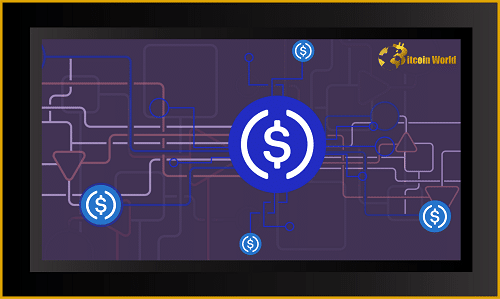Exciting news for the crypto world! If you’re a fan of stablecoins, particularly USD Coin (USDC), get ready for even more accessibility. Circle, the powerhouse behind USDC, just announced a significant expansion that’s set to broaden the reach of this popular digital dollar. Ready to dive into the details?
What’s the Big News with USDC?
At their recent Converge22 conference, Circle’s Chief Product Officer, Nikhil Chandhok, dropped a bombshell: USDC is heading to five new blockchain networks! This isn’t just a small step; it’s a leap that promises to make USDC even more versatile and integrated within the cryptocurrency ecosystem.
Which Blockchains Are Joining the USDC Family?
So, which blockchains can we expect to see USDC on? Here’s the exciting lineup:
- Arbitrum: A leading Layer-2 scaling solution for Ethereum, known for its speed and lower transaction costs.
- NEAR Protocol: A developer-friendly, proof-of-stake blockchain designed for scalability and usability.
- Optimism: Another prominent Layer-2 scaling solution for Ethereum, focused on simplicity and developer experience.
- Polkadot: A multi-chain network that allows different blockchains to interoperate, fostering a connected ecosystem.
- Cosmos: An ecosystem of interconnected blockchains, often referred to as the “Internet of Blockchains.”
While Arbitrum, NEAR, Optimism, and Polkadot are slated to gain USDC support by the end of the year, Cosmos users can anticipate integration in early 2023. This phased rollout ensures a smooth and efficient integration process.
Why is This Expansion So Important?
Think of it this way: the more places you can use a certain currency, the more useful it becomes. USDC, already the second-largest stablecoin by market capitalization (trailing only USDT, according to CoinMarketCap), is making significant strides in accessibility. Both USDC and USDT are pegged to the U.S. dollar, making them a familiar and stable entry point for those transitioning from traditional finance into the world of cryptocurrencies.
Joao Reginatto, Circle’s Vice President of Product, perfectly summed up the impact in a recent press release:
“Extending multi-chain support for USDC opens the door for institutions, exchanges, developers and more to innovate and have easier access to a trusted and stable digital dollar,”
Circle’s vice president of product Joao Reginatto
What Are the Benefits of USDC’s Multi-Chain Support?
This expansion isn’t just about adding more logos to a list. It brings tangible advantages to various players in the crypto space:
- For Institutions: Easier access to a regulated and transparent stablecoin across multiple networks simplifies trading, lending, and borrowing activities.
- For Exchanges: Listing USDC on more chains allows for a wider range of trading pairs and increased liquidity.
- For Developers: Building applications on these blockchains becomes more seamless with readily available and trusted stablecoin integration.
- For Users: Lower transaction fees and faster processing times on some of these networks can make using USDC more efficient and cost-effective.
USDC’s Growing Footprint: A Look at Existing Support
Before this latest announcement, USDC was already available on an impressive nine blockchains. With these additions, the total reaches fourteen, showcasing the growing dominance of USDC in the stablecoin landscape. Currently, you can find USDC on:
- Ethereum
- Solana
- Avalanche
- Polygon
- TRON
- Algorand
- Flow
- Hedera
- Stellar
Making Transfers Easier: The Cross-Chain Transfer Protocol
Circle isn’t stopping at just expanding availability. They’re also tackling the challenge of moving USDC between different blockchains. Enter the new Cross-Chain Transfer Protocol. This innovative solution aims to streamline the transfer of digital assets, making it smoother and more efficient to move USDC across various blockchain ecosystems. Imagine the possibilities for decentralized finance (DeFi) and other applications when moving stablecoins becomes this seamless!
What Challenges Might Arise?
While this expansion is overwhelmingly positive, it’s important to consider potential challenges:
- Integration Complexity: Ensuring seamless integration across diverse blockchain architectures requires careful planning and execution.
- Security Considerations: Maintaining the security and stability of USDC across a larger number of networks is paramount.
- Adoption Rates: While the potential is there, the actual adoption and usage of USDC on these new chains will depend on various factors, including developer activity and user demand.
The Bigger Picture: USDC and the Future of Crypto
USDC’s expansion is a strong indicator of the increasing maturity and interconnectedness of the cryptocurrency space. By becoming available on more blockchains and simplifying cross-chain transfers, USDC is solidifying its position as a foundational asset for the future of digital finance. This move not only benefits USDC holders but also contributes to the overall growth and accessibility of the crypto market.
Key Takeaways: What You Need to Know
- USDC is expanding to Arbitrum, NEAR, Optimism, Polkadot, and Cosmos.
- This expansion will bring the total number of supported blockchains to fourteen.
- The move aims to make USDC more accessible to institutions, exchanges, developers, and users.
- Circle is also introducing a Cross-Chain Transfer Protocol to simplify moving USDC between blockchains.
- This expansion highlights the growing importance of stablecoins in the crypto ecosystem.
Looking Ahead
The expansion of USDC to these five new blockchains marks an exciting chapter for Circle and the broader cryptocurrency community. It promises greater accessibility, enhanced utility, and a more interconnected digital asset landscape. Keep an eye on these developments as they unfold – they could significantly impact how you interact with the crypto world!
Disclaimer: The information provided is not trading advice, Bitcoinworld.co.in holds no liability for any investments made based on the information provided on this page. We strongly recommend independent research and/or consultation with a qualified professional before making any investment decisions.


